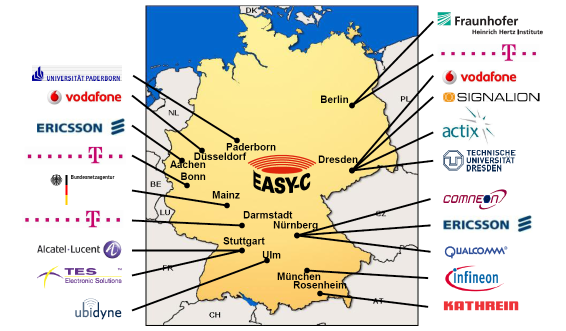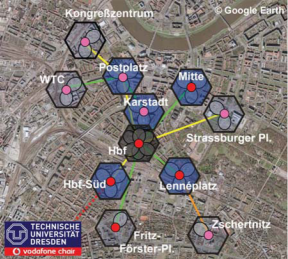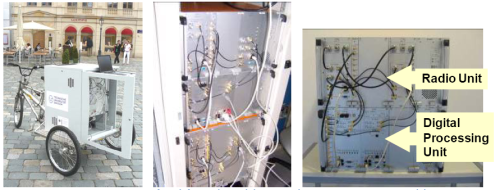LTE/ LTE advanced testbed (TUD, Vodafone)
Important note: For a more detailed and up to date description of the LTE/LTE advanced testbed, please consult the CREW portal. A high-level overview of the testbed is given below.Context
The 3GPP LTE standard is stable now in its first release (Release 8), and the question is how good its performance is in real-world scenarios. LTE is also a good base for further innovations, but it must be proven that they offer performance advantages for the price of their complexity. A variety of advanced concepts such as cooperative MIMO are currently in discussion as future LTE extensions. Such novel schemes are researched within the EASY-C project via lab measurements and a multisite field test bed. The mobile Internet has finally arrived with the worldwide deployment of high-speed packet access (HSPA) networks and broad availability of third-generation (3G) terminals, mobile broadband USB sticks, and notebooks with integrated HSPA modules. With data flatrates, the usage of mobile Internet has skyrocketed in 2008. Third-generation technology was developed more than a decade ago, and the uptake after launch was below expectations in many cases. There are various reasons for that, including initial lack of handset availability and initial technology performance below predictions.
The Next Generation Mobile Networks (NGMN) Alliance has set out requirements for future mobile networks, and the Third Generation Partnership Program (3GPP) is addressing them with the development of long-term evolution (LTE). Among the requirements for LTE are increased average and peak data rates, reduced latency, spectrum flexibility addressing bandwidths of up to 20 MHz, and, last but not least, reduced cost of ownership. The performance of LTE meets the essential NGMN requirements, but not the preferred requirements in important key performance indicators (KPIs) like spectral efficiency and celledge throughput. Therefore, development of LTE technology is continuing beyond Release 8 to address operator requirements.
3GPP has initiated the “LTE-Advanced” study item and defined requirements. The research project Enablers for Ambient Services and Systems — Part C Wide Area Coverage (EASY-C) is developing technologies for future wireless systems such as LTE-Advanced. The special feature of EASY-C is that research ideas are tested in research field testbeds at the system level. In EASY-C, 16 partners work together across the value chain, including academic institutions, mobile operators, network infrastructure, antenna, and test equipment providers, terminal chipset vendors and semiconductor companies, and network planning specialists.
 EASY-C Consortium
EASY-C Consortium
EASY-C Test Bed in Dresden
Two testbeds have been built and operated within the above mentioned research project EASY-C. One of them is the testbed in downtown Dresden Germany, using existing 2G/3G network sites of operators Vodafone and T-Mobile. Both operators are also involved in the trials. An additional testbed focused on applications enabled through LTE and advanced concepts is being set up in Berlin. The chosen testbed location in downtown Dresden covers various propagation conditions, which are of special interest for evaluation of fourth-generation (4G) systems with MIMO links and interference conditions typical in frequency reuse one networks like LTE, and for the development of advanced algorithms such as cooperative MIMO:
- A representative area of a medium-sized European city
- Hills in the south causing signal reflections
- A river through the city causing superrefractions and tropospheric refraction
- Urban areas with multistory buildings, leading to shadowing effects
- An average intersite distance of 500 m
In the first phase, one site with three cells started operating in April 2008. As shown in the picture below, this central site is located near Dresden’s main railway station.
 EASY-C cell structure downtown Dresden
EASY-C cell structure downtown Dresden
EASYC - Contribution for CREW
The TUD contribution will be based on the EASY-C campus infrastructure, i.e, the EASY-C outdoor lab test bed which is directly operated by the Vodafone Chair research team. An LTE-like cellular infrastructure will be used where relevant network parameters are measured such as frame error rates, outage events, throughput or latency. One base station at rooftop level will be used which serves multiple UEs. This BS resides at the faculty of electrical engineering and information technology, TUD. Stationary and mobile user equipment will be used. Below are depicted, from left to right: mobile test UE, base station equipment, UE lab equipment.
 EASY-C test equipment.
EASY-C test equipment.
External users of the TUD test bed will install their own equipment at the TUD test site. A predefined test setup is used which provides well defined and reproducible EASY-C LTE traffic – good for the CREW cognitive radio benchmarking initiative. The LTE network parameters are constantly monitored and recorded. The CR transceivers are then activated where the LTE performance parameters are compared for the non-CR and CR case. Hence, it will be possible to benchmark the impact of various CR schemes on a cellular infrastructure through a well defined set of reproducible test setups.
The Vodafone Chair as research facility will develop cognitive radio test cases as well. The envisaged algorithms will sense the quality of the analog transceiver frontends – an ambitious goal related to the well known Dirty-RF1 paradigm. Taking into account the transceivers quality, new and more precise cognitive radio decision making and resource allocation will become possible.